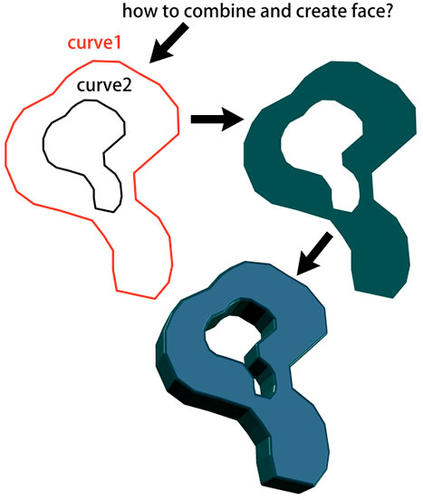combine curves
what is the procedure using two curves, to create a shape with a hole in it?
Imported some AI curves and I need to combine them and create a surface.
like the letter "o"


hexagon_face1.jpg
467 x 552 - 34K
Post edited by sadicus on


Comments
Use the "Ruled surfaces" tool under the surfaces tab - make sure the curves have an equal number of points on each curve and that when you click to make it, you select on matching points:)
Also to note: for most programs (including Ai), nested paths made to create "holes" are 'compound' paths. For example text (converted to shapes) such as a "D" or "0" (but not an "L") or any path shapes to make "logical" holes.
You can export a compund path from Ai...works well in Carrara; don't think I ever did that in Hex and maybe Hex does not understand a compound path...but good to know for most any other 3D program.
Hexagon does not understand/work with compound AI files. If the OP does not have Carrara. then "Wings 3d" would produce the result (solid) required, simply by importing the compound AI file.
If you want/need a quick solution, then if you have Carrara, use that, or, you could use Wings3D http://www.wings3d.com/
In Hexagon, I would create like this:-
(these are the main steps. If you want to use this method, then just ask if you need more info.)
1: AI imported curves
2: Extrude Curves
3: Add thickness and remove un-needed faces (step used to give good topology on edges)
4: Use Bridge to cut up produced (in next step) N-gons
5: Close -> All
6: Triangulate N-gons
7: Chamfer if required.
Don't have .ai, so don't know about the compound curves - I took the OP at his word and imagined two whole curves, as I get in Gimp and InkScape. Anyhow, I traced his inner curve in Hex, offset it and used Ruled surfaces, no problem:)
That is because you offset the inner curve, so you do not get the problem with the shape shown by OP.
Make the outer shape scaled and offset as shown by OP. You will see the problem.
Here is example:-
You are quite right - I stand corrected:)
Can be a bit of a nuisance untangling the overlapping points, but it is do-able, although your method is less hassle.
A variation on your method that I use for these difficult shapes is to extrude and bridge - adding points where necessary to avoid cross-overs and to be sure of getting only quads - just a thing I have about tri's:)
Delete the two bottom loops and add thickness.
For a simple shape as shown in example, then not much work. But what if you had an imported AI file with thousands of points with multiple holes. Would you really take the time to attempt all quads unless specifically asked for (needed)?
Do you really get situations like that? Thankfully, I don't foresee anything like that coming my way and as an amateur, I doubt that anyone will ever require me to do so:)
If it did, I'd probably pop it into the Carrara spline modeler and let it do the tri's for me!
For a simple shape as shown in example, then not much work. But what if you had an imported AI file with thousands of points with multiple holes. Would you really take the time to attempt all quads unless specifically asked for (needed)?
Interesting thread....one question what is an ai file?
Ai file = native file format saved by Adobe Illustrator = name.ai
And it is 2D vector lines/paths that many other programs can import and use OK. Somewhat of a standard by default. And format can include info to comprehend "compound" paths.
Carrara can easily import version 3 of Illustrator (even the latest version of Illustrator can save-as version 3)....and maybe up to version 8 or 9; can't remember off-hand.
If, like me your hobby doesn't justify the expense of Illustrator, you can draw shapes in Inkscape, save as .svg (scalable vector graphics) and convert to .ai using Uniconverter (both free Opensource). This converts to .ai 5, which is compatible with Hex.
Lots of fun to be had:)
That's useful to know...thanks!